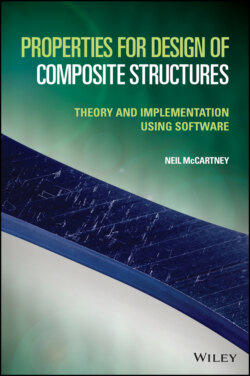Читать книгу Properties for Design of Composite Structures - Neil McCartney - Страница 25
2.9.2 Local Thermodynamic Relations
ОглавлениеThe extensive quantities are not used directly in simulations, as local expressions of these thermodynamic quantities defined per mole, per unit mass or per unit volume need to be defined. The approach to be taken here is to define thermodynamic variables per unit mass by introducing the state variables υ,ψ ,φ ,Ω and η using the relations
(2.61)
implying that
(2.62)
where υ,ψ and φ are the specific internal, specific Helmholtz and specific Gibbs energies, respectively, Ω is the volume per unit mass (i.e. 1/ρ where ρ is the mass density), whereas η and ωk,k=1,…,n are, respectively, the specific entropy and mass fractions for the n species. Substitution of (2.61) into (2.54) then leads to
(2.63)
where use has been made of the following relation derived using (2.60) and (2.61)
(2.64)
On setting λ=1/M in (2.59) and on using (2.61) the local equations of state are given by
(2.65)
The differential relations (2.63) imply that
(2.66)
It should be noted that the set of mass fractions {ωk} appearing as state variables in (2.65) are not independent because their sum is unity as shown in (2.61). The partial derivatives with respect to mass fractions given in (2.66) must, however, be calculated under the assumption that the mass fractions are independent variables but that the relationship (2.62) is not yet assumed to be satisfied. This means that relation (2.62) cannot yet be used to simplify or modify the functions U^,F^orG^. It should also be noted that the functions U^,F^andG^ appearing in the local relations (2.66) are, in fact, defined for uniform systems at a global level, as shown in (2.54) where the set of state variables {Mk}, corresponding to {ωk}, are independent. As soon as all partial derivatives with respect to mass fractions have been calculated, it is then possible to simplify or modify results by making use the mass fraction relation (2.62).
The description of thermodynamic relations given here applies to multi-component fluids in equilibrium, and to solids provided the stress state is hydrostatic so that shear stresses are absent. In particular, the relations apply to the uniform initial reference state of elasticity theory where the background pressure and temperature are both uniform. Although the thermodynamic relations have been given for multi-component systems, it is emphasised that this is referring to mixtures of atoms and/or molecules of the various n species, which is an example of an ‘atomistic’ composite. Throughout this book there is no need to consider materials and associated models at the atomistic length scale, as all materials are considered homogenised into macroscopic continua. The composites to be considered are formed from a continuum representing the matrix and one or more types of reinforcement which are also modelled as continua. When applying thermodynamic principles to continua, it is sufficient to regard each material present as a thermodynamic system having just a single component so that n = 1. On using (2.62) it is then clear that ω1=1. The equations of state (2.65) may then be written in the form
(2.67)
and the differential relations (2.63) reduce to the simpler forms
(2.68)
whereas relations (2.66) reduce to
(2.69)
The analysis of this section has been presented as it establishes a basis for connecting composite modelling to the well-known principles of thermodynamics. The relationships (2.67)–(2.69) apply to single-component solids subject only to hydrostatic stress states leading to the possibility of specifying constitutive equations that depend on a limited set of material properties, e.g. bulk modulus and bulk thermal expansion coefficient. To extend the analysis to all types of thermoelastic material properties needed for the applications to be considered in this book, it is required to introduce in the next section strain tensors as state variables, rather than the specific volume Ω introduced in (2.65) and (2.67).
